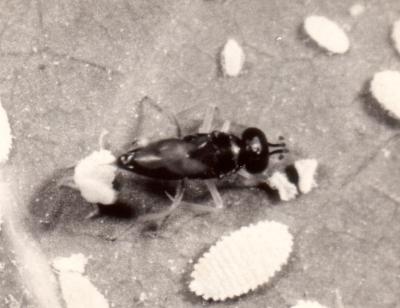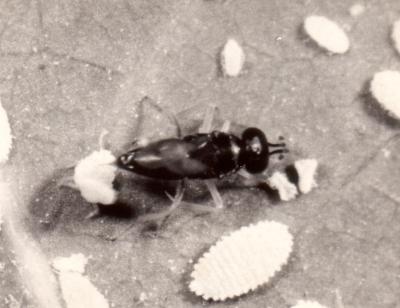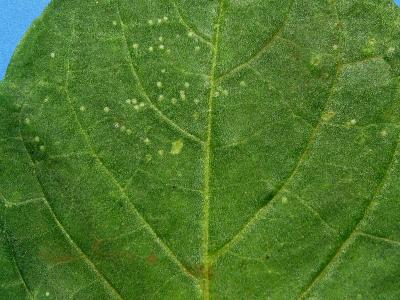


Cassava mealybug (Phenacoccus manihoti)
The cassava mealybug is pinkish in colour. Its body is surrounded by very short filaments, and covered with a fine coating of wax. Adults are 0.5-1.4 mm long. This mealybug does not have males. Females live for about 20 days and lay 400 eggs in average. The lifecycle from egg to adult is completed in about 1 month at 27°C. It reproduces throughout the year and it reaches peak densities during the dry season. Mealybugs are dispersed by wind and through planting material.
The cassava mealybug strongly prefers cassava and other Manihot species; other host crops and wild hosts are only marginally infested. It sucks sap at cassava shoot tips, on the lower surface of leaves, and on stems. During feeding the mealybug injects a toxin into the cassava plant causing deformation of terminal shoots, which become stunted, resulting in compression of terminal leaves into "bunchy tops". The length of internodes is reduced, and stems are distorted. When attack is severe plants die, starting at the plant tip, where most mealybugs are found.
Mealybug attack results in leaf loss and poor quality planting material (stem cuttings) due to dieback and weakening of stems used for crop propagation. Tuber losses have been estimated up to 80%. The pest-induced defoliation reduces availability of healthy leaves, which are consumed as leafy vegetables in most of West and Central Africa. After the pest cripples plant growth, weed and erosion sometimes lead to total destruction of the crops. In general, yield losses depend upon age of plant when attacked, length of dry season, severity of attack and general conditions of the plant. Mealybug damage is more severe in the dry than in the wet season.
The cassava mealybug was accidentally introduced to Africa from South America. After the first reports in the 1970s, the insect became the major cassava pest within a few years and spread rapidly through most of the African cassava belt. The outbreak led to famine in several countries where cassava is a staple crop and particularly important in times of drought. In an attempt to control this pest natural enemies, mainly parasitic wasps and ladybird beetles, were introduced from South America.
The most effective has been the parasitic wasp (Apoanagyrus (=Epidinocarsis) lopezi), which has kept this mealybug at low levels, resulting on significant reduction of yield losses in most areas in Africa (Neuenschwander, 2003).
- Plant early in the rainy season to allow the cassava plants a good growth before the dry season. Strong plants are more likely to withstand pest attacks.
- Use soil amendments and mulch to avoid moisture stress in sandy or poor soils. Mealybug numbers are higher on cassava grown on poor, sandy soils, and may cause damage in spite of the presence of natural enemies.
- Avoid using infested plant material. Before planting cutting can be treated with hot water [by immersing them in heated water (mixing equal volumes of boiling and cold water) for 5-10 minutes just before planting] to kill all insects/mites and to avoid transfer into the newly planted field. For more information on Hot water treatment click here.
- Avoid using pesticides on crops surrounding cassava fields. Although, no pesticides are used on cassava in Africa, insecticide drift from neighbouring fields may affect natural enemies that keep mealybugs and other pests under control.
- Use of manure or other fertilisers can result in a reduction in the mealybug population because improved nutrition results in the production of larger parasitoid wasps with higher fertility levels. Mulch and fertilizer use also enhances the antibiotic properties of cassava against mealybug infestation.
